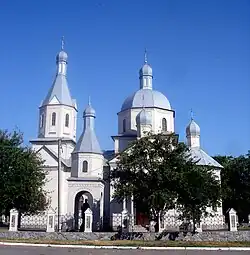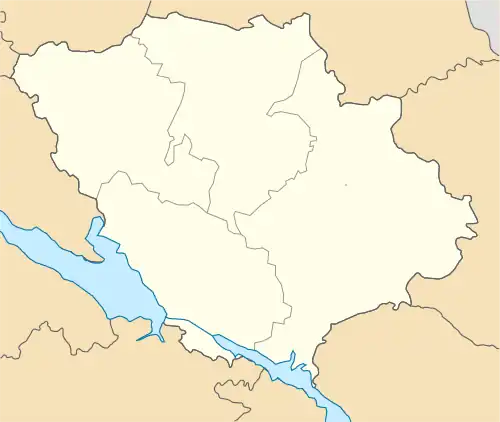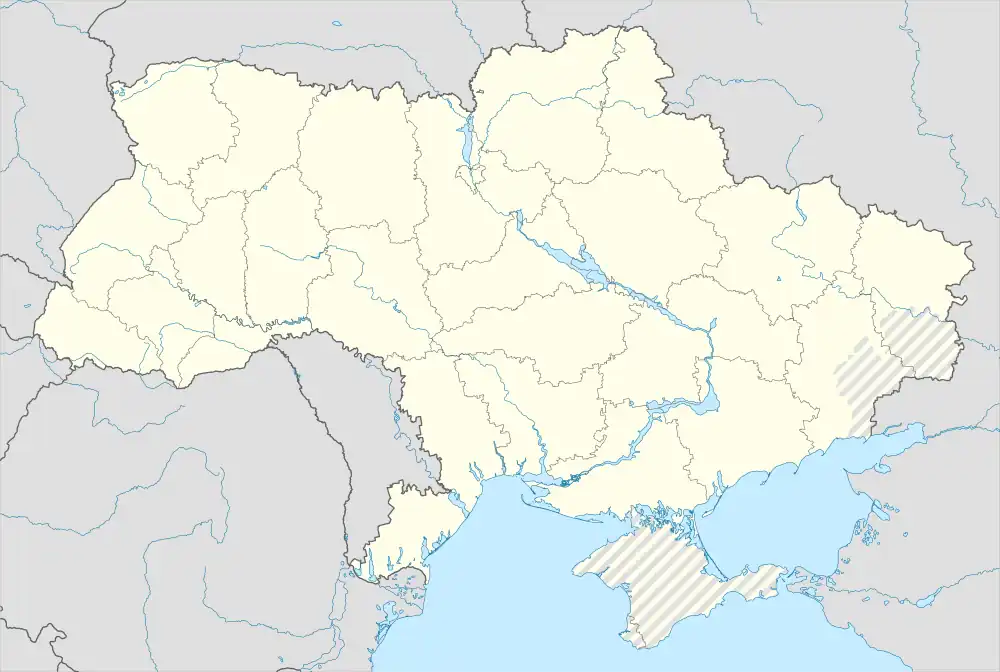Zinkiv
Zinkiv (Ukrainian: Зінькі́в, pronounced [z⁽ʲ⁾inʲˈk⁽ʲ⁾iu̯]) is a city on the Tashan River in the Poltava Oblast in central Ukraine. The city was previously the administrative center of the Zinkiv Raion until 2020, when it became part of the Poltava Raion. It hosts the administration of Zinkiv urban hromada, one of the hromadas of Ukraine.[2] The city's estimated population in 2022 was 9,168 (2022 estimate).[1]
Zinkiv
Зіньків | |
|---|---|
 Nativity Church in Zinkiv | |
 Flag  Coat of arms | |
 Zinkiv Location of Zinkiv within the Poltava Oblast  Zinkiv Zinkiv (Ukraine) | |
| Coordinates: 50°12′37″N 34°21′29″E | |
| Country | |
| Oblast | |
| Raion | Poltava Raion |
| Elevation | 132 m (433 ft) |
| Population (2022) | |
| • Total | 9,168[1] |
| • Density | 1,400/km2 (4,000/sq mi) |
| Time zone | UTC+2 (EET) |
| • Summer (DST) | UTC+3 (EEST) |
| Postal code | 36000—36499 |
| Area code | +380 |
In the 19th century, Zinkov was a leading center of Hasidic Judaism. Under the Nazi occupation of the city during World War II, almost all of the city's 2,300-strong Jewish population was murdered.
Name
In addition to the Ukrainian Зіньків (Zinkiv), in other languages the name of the city is Russian: Зиньков, romanized: Zinkov and Yiddish: זינקיוו.
History
17th to 19th century
The first recorded mention of Zinkiv was in 1604. The city was greatly affected by the Khmelnytsky Uprising, a Cossak rebellion between 1648 and 1657, which was accompanied by mass atrocities that destroyed the Jewish community in Zinkov. The city's importance grew during the 17th century Cossack Hetmanate. After the Polish–Cossack–Tatar War in the late 1660s, the city became an important fortification in the Poltava Regiment.[3][4]
Jews had resettled in Zinkov by the early 18th century, but were murdered by the haidamaks, anti-Polish Ukrainian insurgents, in 1734. The arrival of Polish rabbi Avraham Yehoshua Heshel and his son Yitzchak Meir in the second half of the 18th century reinvigorated the Jewish presence, and Zinkiv became a leading center of Hasidic Judaism in the Podolia area.[4] By the mid-18th century, Hetman Kirill Razumovski had been granted jurisdiction of the city by Empress Elizabeth of Russia.[3]
By the 19th century, Zinkiv had flourishing manufacturing and trading industries.[3] In 1897, the city's population was 7,017, 53 percent of whom were Jews.[4]
20th century
After the establishment of the Soviet Union, a kolkhoz collective farm was established in the city. Many of the city's Jews, who comprised 35 percent of the population, worked as artisans and craftsmen in state-owned cooperatives.[4]
World War II
At the outbreak of World War II in 1939, the city was home to 2,248 Jews.[4]
On June 22, 1941, Nazi Germany and many of its Axis allies invaded the Soviet Union as part of Operation Barbarossa. By July 10, the Nazis had occupied Zinkov. In August, the Nazis established a Judenrat, an administrative body that would oversee affairs of the city's Jews and coordinate dealings with the Nazi authorities.[4]
One of the Judenrat's responsibilities was to coordinate the Jews' sequestration into a ghetto, which in Zinkiv consisted only of a single house.[5] The Nazi authorities imposed a series of discriminatory measures against the Jewish population. Jews were also forced to pay ransoms and systematically dispossessed of their belongings and gold. Those over the age of 10 were required to wear a yellow badge on their chest and backs and were forbidden to walk on sidewalks. To humiliate the Jews, the Germans and their Ukrainian collaborators cut the beards and payos of religious Jews, including the city's rabbi, in a practice reportedly called "taking the Jews to the barber."[4]
In 1942, the Nazis ramped up their killing operations against Zinkiv's Jews. On May 9, 1942, approximately 600 Jews, many infirm, elderly, and women with children, were shot to death and buried in a mass grave approximately 1.5 kilometers outside the city.[4][6] On August 4, an additional 1,882 Jews were shot to death at the same site. Able-bodied men were sent to forced labor camps at Proskurov and Leznyevo, leaving 150 Jewish workers in the ghetto.[4]
The Soviet Red Army liberated Zinkov in March 1944, ending the Nazi occupation of Zinkiv.[4] Only approximately 30 Jews in Zinkiv survived the war.[6]
Population
Gallery
.JPG.webp) Modern architecture in Zinkiv
Modern architecture in Zinkiv.JPG.webp) Neo-gothic bank building
Neo-gothic bank building History museum
History museum Downtown Zinkiv
Downtown Zinkiv
References
- Чисельність наявного населення України на 1 січня 2022 [Number of Present Population of Ukraine, as of January 1, 2022] (PDF) (in Ukrainian and English). Kyiv: State Statistics Service of Ukraine. Archived (PDF) from the original on 4 July 2022.
- "Зеньковская громада" (in Russian). Портал об'єднаних громад України.
- "Zinkiv (Poltava oblast)". Internet Encyclopedia of Ukraine. Canadian Institute of Ukrainian Studies. Archived from the original on 24 May 2023. Retrieved 24 May 2023.
- "Zinkov". Yad Vashem. Archived from the original on 24 May 2023. Retrieved 24 May 2023.
- Berkhoff, Karel (2018). Basic Historical Narrative of the Babi Yar Holocaust Memorial Center (PDF). Kyiv, Ukraine: Babi Yar Holocaust Memorial Center. p. 100. Archived (PDF) from the original on 2023-03-25. Retrieved 2023-07-03.
- "Pinchas Zinkiv". National Library of Israel. Archived from the original on 3 July 2023. Retrieved 9 June 2023.
- https://socialdata.org.ua/projects/mova-2001/